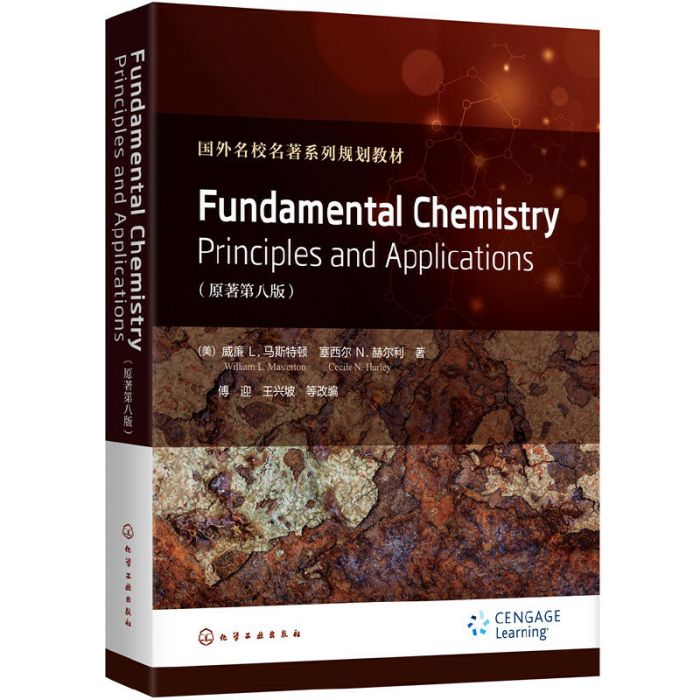《Fundamental Chemistry Principles and Applications》是2019年化學工業出版社出版的圖書,作者是(美)威廉 L. 馬斯特頓(William L. Masterton)、(美)塞西爾 N. 赫爾利(Cecile N. Hurley)。
《Fundamental Chemistry: Principles and Applications》主要參考我國醫學類相關專業《基礎化學》教學大綱所規定的教學內容改編而成,整合改編後共15章內容,主要包括:原子(Atoms)、電子結構和元素周期表(Electronic Structure and the Periodic Table)、共價鍵(Covalent Bonding)、熱力學(Thermochemistry)、自發反應(Spontaneity of Reaction)、氣體的化學平衡(Gaseous Chemical Equilibrium)、反應速率(Rate of Reaction)、液體和固體(Liquids and Solids)、溶液(Solutions)、酸和鹼(Acids and Bases)、酸鹼平衡(Equilibria in Acid-Base Solutions)、沉澱溶解平衡(Precipitation Equilibrium)、電化學(Electrochemistry)、配位化合物(Complex Ions)以及核反應(Nuclear Reactions)。在本書的改編過程中,在尊重原教材著作權的基礎上,編者在遵循適合我國教材所涵蓋的知識體系的同時,儘可能體現原書的風格和特點,使內容更加精煉緊湊。
《Fundamental Chemistry: Principles and Applications》可供國內基礎、臨床、口腔、麻醉、預防、護理、生物工程、藥學等醫學類相關專業基礎化學類課程的雙語教學和留學生教學使用,也可供其他專業基礎化學雙語教學的師生及科技工作者用作參考書。
傅迎,大連醫科大學,教授、碩士研究生導師,<授課方面>
1、本科藥學、臨床藥學專業:無機化學與物理化學
2、本科、本碩連讀(5 3)臨床醫學專業:基礎化學
3、本科留學生臨床醫學專業(全英):Basic Chemistry
4、本科衛生檢驗與檢疫專業:食品理化檢驗
5、本科藥學、臨床藥學、臨床檢驗等專業:儀器分析
<科研方面>
研究方向:分子生物學技術在臨床檢驗套用中的研究
1、2008~2017年,省立項課題:基於代謝組學的中藥複方活性成分的分析語藥效評價的研究等三項,主要參與人。
3、2012年中華醫學會醫學教育分會、中國高等教育學會醫學教育專業委員會年2012度醫學教育研究立項課題:2012-GW-10 國內外醫學基礎化學教育的比較研究 ,項目主持人。
4、2015年大連醫科大學留學生全英文授課品牌課:項目主持人
5、2017遼寧省教育科學規劃立項課題:醫學檢驗虛擬仿真實驗教學的建設與實踐,JG14DB139,主要參與人
6、SCI收錄學術論文多篇,教學論文多篇。
1 Atoms 1
1-1 Atoms and the Atomic Theory 1
1-2 Components of the Atom 2
The Human Side: John Dalton 3
1-3 Quantitative Properties of the Atom 5
1-4 Introduction to the Periodic Table 11
Beyond The Classroom: Mastering the Peri’god’ic Table 14
Summary Problems 16
Questions and Problems 16
2 Electronic Structure and the Periodic Table 19
2-1 Light, Photon Energies, and Atomic Spectra 20
2-2 The Hydrogen Atom 25
2-3 Quantum Numbers 28
2-4 Atomic Orbitals; Shapes and Sizes 32
2-5 Electron Configurations in Atoms 33
The Human Side: Glenn Theodore Seaborg 37
2-6 Orbital Diagrams of Atoms 38
2-7 Electron Arrangements in Monatomic Ions 40
2-8 Periodic Trends in the Properties of Atoms 43
Beyond The Classroom: Why Do Lobsters Turn Red When Cooked 47
Summary Problems 49
Questions and Problems 49
3 Covalent Bonding 52
3-1 Lewis Structures; The Octet Rule 53
The Human Side: Gilbert Newton Lewis 62
3-2 Molecular Geometry 62
3-3 Polarity of Molecules 70
3-4 Atomic Orbitals; Hybridization 73
Beyond The Classroom: The Noble Gases 80
Summary Problems 81
Questions and Problems 81
4 Thermochemistry 85
4-1 Principles of Heat Flow 86
4-2 Measurement of Heat Flow; Calorimetry 90
4-3 Enthalpy 93
4-4 Thermochemical Equations 94
4-5 Enthalpies of Formation 100
4-6 Bond Enthalpy 105
4-7 The First Law of Thermodynamics 107
Beyond The Classroom: Energy Balance in the Human Body 111
Summary Problems 113
Questions and Problems 113
5 Spontaneity of Reaction 116
5-1 Spontaneous Processes 117
5-2 Entropy, S 119
5-3 Free Energy, G 123
The Human Side: J. Willard Gibbs 125
5-4 Standard Free Energy Change, ΔG 125
5-5 Effect of Temperature, Pressure, and Concentration on Reaction Spontaneity 129
5-6 The Free Energy Change and the Equilibrium Constant 134
5-7 Additivity of Free Energy Changes; Coupled Reactions 135
Beyond The Classroom: Rubber Elasticity: An Entropic Phenomenon 137
Summary Problems 139
Questions and Problems 139
6 Gaseous Chemical Equilibrium 144
6-1 The N2O4–NO2 Equilibrium System 145
6-2 The Equilibrium Constant Expression 148
6-3 Determination of K 153
6-4 Applications of the Equilibrium Constant 156
6-5 Effect of Changes in Conditions on an Equilibrium System 161
Beyond The Classroom: An Industrial Application of Gaseous Equilibrium 166
Summary Problems 168
Questions and Problems 169
7 Rate of Reaction 171
7-1 Meaning of Reaction Rate 171
7-2 Reaction Rate and Concentration 174
7-3 Reactant Concentration and Time 180
7-4 Models for Reaction Rate 186
The Human Side: Henry Eyring 189
7-5 Reaction Rate and Temperature 190
7-6 Catalysis 193
7-7 Reaction Mechanisms 195
Beyond The Classroom: The Ozone Story 199
Summary Problems 201
Questions and Problems 202
8 Liquids and Solids 206
8-1 Comparing Solids, Liquids, and Gases 206
8-2 Liquid-Vapor Equilibrium 207
8-3 Phase Diagrams 213
8-4 Molecular Substances; Intermolecular Forces 216
Beyond The Classroom: Supercritical Carbon Dioxide 222
Summary Problems 224
Questions and Problems 224
9 Solutions 227
9-1 Concentration Units 227
9-2 Principles of Solubility 236
9-3 Colligative Properties of Nonelectrolytes 241
9-4 Colligative Properties of Electrolytes 250
Beyond The Classroom: Maple Syrup 252
Summary Problems 254
Questions and Problems 254
10 Acids and Bases 257
10-1 Br nsted-Lowry Acid-Base Model 257
10-2 The Ion Product of Water 259
10-3 pH and pOH 259
10-4 Weak Acids and Their Equilibrium Constants 265
10-5 Weak Bases and Their Equilibrium Constants 274
10-6 Acid-Base Properties of Salt Solutions 278
10-7 Extending the Concept of Acids and Bases: The Lewis Model 281
Beyond The Classroom: Organic Acids and Bases 282
Summary Problems 285
Questions and Problems 285
11 Equilibria in Acid-Base Solutions 288
11-1 Buffers 288
11-2 Acid-Base Indicators 299
11-3 Acid-Base Titrations 302
Beyond The Classroom: Acid Rain 311
Summary Problems 313
Questions and Problems 313
12 Precipitation Equilibria 316
12-1 Solubility; Solubility Product Constant (Ksp) 316
12-2 Precipitate Formation 323
12-3 Dissolving Precipitates 327
Beyond The Classroom: Qualitative Analysis 331
Summary Problems 333
Questions and Problems 334
13 Electrochemistry 337
13-1 Oxidation-Reduction Reactions Revisited 338
13-2 Voltaic Cells 342
13-3 Standard Voltages 346
13-4 Relations Between E , DG , and K 353
13-5 Effect of Concentration on Voltage 355
Beyond The Classroom: Fuel Cells: The Next Step in Chemical-to-Electrical-Energy Conversion 359
Summary Problems 361
Questions and Problems 362
14 Complex Ions 366
14-1 Composition of Complex Ions 367
14-2 Naming Complex Ions and Coordination Compounds 371
14-3 Geometry of Complex Ions 373
14-4 Electronic Structure of Complex Ions 377
The Human Side: Alfred Werner 377
14-5 Complex Ion Equilibria; Formation Constant (Kf) 382
Beyond The Classroom: Chelates: Natural and Synthetic 384
Summary Problems 386
Questions and Problems 387
15 Nuclear Reactions 389
15-1 Nuclear Stability 389
15-2 Radioactivity 391
The Human Side: Marie and Pierre Curie with daughter Irene, at their home near Paris 397
15-3 Rate of Radioactive Decay 397
15-4 Mass-Energy Relations 400
15-5 Nuclear Fission 404
15-6 Nuclear Fusion 407
Beyond The Classroom: Biological Effects of Radiation 409
Summary Problems 410
Questions and Problems 410
Appendices
Appendix 1 Units, Constants and Reference Data 413
Appendix 2 Properties of the Elements 419
Appendix 3 Exponents and Logarithms 421
Appendix 4 Molecular Orbitals 426
Appendix 5 Answers to All Questions and Problems 431
Conversion Factors 443
Table of Atomic Masses 444
IUPAC Periodic Table of the Elements 445

